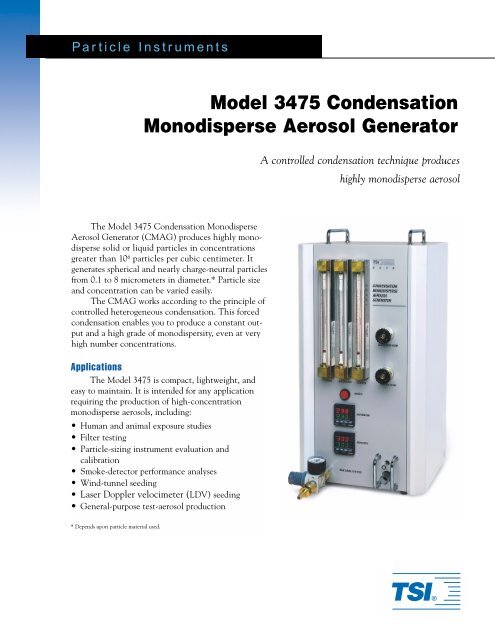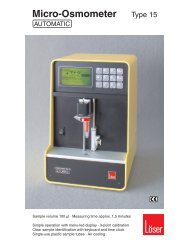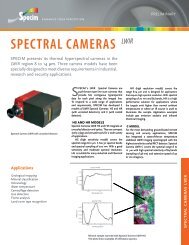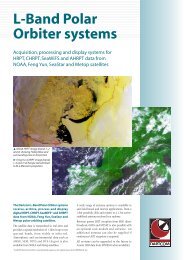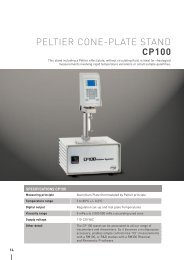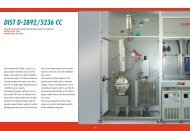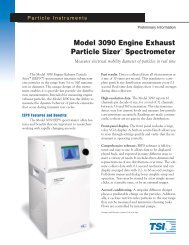Model 3475 Condensation Monodisperse Aerosol Generator
Model 3475 Condensation Monodisperse Aerosol Generator
Model 3475 Condensation Monodisperse Aerosol Generator
You also want an ePaper? Increase the reach of your titles
YUMPU automatically turns print PDFs into web optimized ePapers that Google loves.
Particle Instruments<br />
<strong>Model</strong> <strong>3475</strong> <strong>Condensation</strong><br />
<strong>Monodisperse</strong> <strong>Aerosol</strong> <strong>Generator</strong><br />
A controlled condensation technique produces<br />
highly monodisperse aerosol<br />
The <strong>Model</strong> <strong>3475</strong> <strong>Condensation</strong> <strong>Monodisperse</strong><br />
<strong>Aerosol</strong> <strong>Generator</strong> (CMAG) produces highly monodisperse<br />
solid or liquid particles in concentrations<br />
greater than 10 6 particles per cubic centimeter. It<br />
generates spherical and nearly charge-neutral particles<br />
from 0.1 to 8 micrometers in diameter.* Particle size<br />
and concentration can be varied easily.<br />
The CMAG works according to the principle of<br />
controlled heterogeneous condensation. This forced<br />
condensation enables you to produce a constant output<br />
and a high grade of monodispersity, even at very<br />
high number concentrations.<br />
Applications<br />
The <strong>Model</strong> <strong>3475</strong> is compact, lightweight, and<br />
easy to maintain. It is intended for any application<br />
requiring the production of high-concentration<br />
monodisperse aerosols, including:<br />
• Human and animal exposure studies<br />
• Filter testing<br />
• Particle-sizing instrument evaluation and<br />
calibration<br />
• Smoke-detector performance analyses<br />
• Wind-tunnel seeding<br />
• Laser Doppler velocimeter (LDV) seeding<br />
• General-purpose test-aerosol production<br />
* Depends upon particle material used.
Operation<br />
The <strong>Model</strong> <strong>3475</strong> CMAG uses a controlled condensation<br />
technique to produce monodisperse aerosols.<br />
Based on the Sinclair-LaMer principle, this operational<br />
approach involves condensing a vapor onto condensation<br />
nuclei.<br />
Using nitrogen as the carrier gas, an atomizer inside<br />
the CMAG produces a spray from a low-concentration,<br />
aqueous solution of sodium chloride. The droplets<br />
pass through a drying column, where they dry to form a<br />
high-concentration nuclei aerosol. The condensation<br />
nuclei travel to a thermostatically controlled saturator<br />
vessel and bubble through a substance with low volatility,<br />
such as diethylhexyl sebacate (DEHS), dioctyl phthalate<br />
(DOP), Emery 3004, or paraffin or carnauba waxes.<br />
The carrier gas, nuclei, and vaporized substance<br />
move from the saturator into a reheater unit, which<br />
serves to ensure that the aerosol material is completely<br />
vaporized. From the reheater unit, the nuclei and vapor<br />
move into an air-cooled condensation chimney. It is<br />
here that, once a preset supersaturation level has been<br />
reached, the controlled heterogeneous condensation<br />
process begins, resulting in a highly monodisperse<br />
aerosol.<br />
Mean particle size is dependent on the ratio of<br />
the vapor concentration to the nuclei number concentration.<br />
You can control vapor concentration, and<br />
therefore, particle size by adjusting the saturator temperature<br />
and the proportion of the total flow passing<br />
through the saturator unit.<br />
The CMAG allows you to make very rapid<br />
changes to particle size over a limited range by varying<br />
the saturator flow rate alone. For instance, with DOP<br />
or DEHS, only three different temperature settings are<br />
required to cover the range from 0.1 to 5 micrometers.<br />
The generator’s specially designed aerosol outlet meets<br />
the requirement for high monodispersity by selecting<br />
the central flow where the temperature gradient is lowest<br />
and, consequently, the size distribution is narrowest.<br />
To produce monodisperse aerosol with particles up to 8<br />
micrometers, you must divert a portion of the nuclei<br />
through a filter, reducing the nuclei number concentration<br />
in a controlled manner until you achieve a higher<br />
relative concentration of vapor.<br />
Concentration (particles/cm 3 )<br />
10 4<br />
5×10 3<br />
0<br />
0.7 1 2 3 5 7 10<br />
Aerodynamic Particle Diameter (µm)<br />
<strong>Monodisperse</strong> aerosol produced by the <strong>Model</strong> <strong>3475</strong> using the reduction<br />
of the nuclei number concentration<br />
Flowmeter<br />
(total)<br />
Flowmeter<br />
(screen-bypass)<br />
Flowmeter<br />
(saturator)<br />
Reheater<br />
Screen<br />
HEPA Filter<br />
Heated Saturator<br />
N 2<br />
Flow<br />
Valve<br />
Diffusion<br />
Dryer<br />
Flow Valve<br />
Flow Valve<br />
<strong>Condensation</strong><br />
Chimney<br />
Atomizer<br />
<strong>Monodisperse</strong><br />
aerosol out
Specifications<br />
<strong>Model</strong> <strong>3475</strong> <strong>Condensation</strong> <strong>Aerosol</strong> <strong>Generator</strong><br />
Mode of Operation<br />
Particle Type<br />
Liquid<br />
Solid<br />
Bibliography<br />
Modified Sinclair-LaMer generator<br />
DES (nontoxic), DOP, or<br />
Emery 3004<br />
Carnauba wax (nontoxic),<br />
paraffin, or stearic acid<br />
Particle-Size Range for Selected Materials<br />
DEHS, DOP 0.1 to 8 µm<br />
Carnauba Wax 0.1 to 4 µm<br />
Stearic Acid 0.1 to 9 µm<br />
<strong>Aerosol</strong> Geometric Standard Deviation<br />
TSI Incorporated<br />
500 Cardigan Road , Shoreview, MN 55126 U.S.A.<br />
Tel: 651 490 2811 Toll Free: 1 800 874 2811 Fax: 651 490 3824 E-mail: particle@tsi.com<br />
TSI Germany<br />
Neuköllner Str. 4, 52068 Aachen, Germany<br />
Tel: +49-241-52303 0 Fax: +49-241-5230349 E-mail: particle-europe@tsi.com<br />
For current information<br />
www.tsi.com<br />
P/N 1931229 Rev. A Copyright © 2002 by TSI Incorporated Printed in U.S.A.


